The second test jump from an altitude of 97,145.7 feet / 29,610 meters represented a significant achievement for the Red Bull Stratos team but has resulted in pushing the final mission – a free fall from the edge of space – back to October. Felix Baumgartner’s capsule suffered damage after landing on rugged terrain and is currently undergoing repairs.
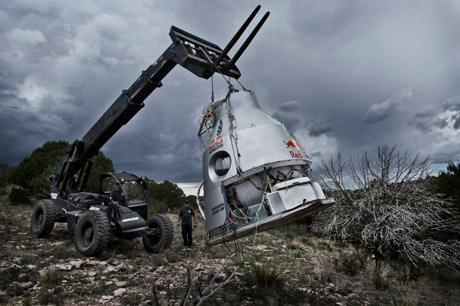
Crew members recover the capsule in the desert after the successfully compleated second manned test flight for Red Bull Stratos in Roswell, New Mexico, USA on July 25, 2012. Photo: balazsgardi.com/Red Bull
ROSWELL, New Mexico (USA) – When Felix Baumgartner successfully completed his second test jump, landing safely in the New Mexico desert, the team was in a celebratory mood following an intensive week of weather delays. The free fall was higher than planned, making it the second highest jump in history, eclipsed only by Joe Kittinger’s world record set in 1960.
The 43-year-old Austrian plunged to earth at speeds of up to 536.8 mph / 864 kmh during a 3 minute 48 second free fall. The ascent, free fall and landing went according to plan. Previous technicalities from Baumgartner’s first test flight had been resolved, such as bitterly cold temperatures permeating his protective gloves and freezing his hands to a point where he could barely pull his parachute rip cord. Baumgartner said right after landing: “The more practice you have, the more confidence you have. We now have a good feeling of what to expect and are ready to go."
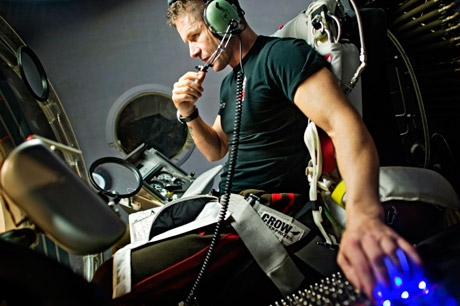
Pilot Felix Baumgartner of Austria seen during the egrass training for the Red Bull Stratos in Lancaster, California, USA on February 22 2012. Photo: Jörg Mitter/Red Bull
However, several hours later the Recovery Team reached the capsule, used during the ascent, and discovered it had sustained damage on landing. After Baumgartner jumped from the capsule, it was detached from the balloon shortly before it would have drifted into U.S. military airspace southwest of Roswell. However, after descending under parachute it landed on a rocky, uneven surface and was thrown onto its side.
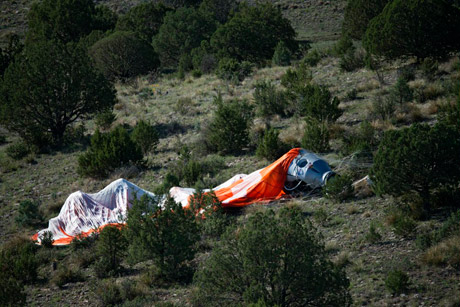
The capsule lays at the desert after a hard landing during the second manned test flight for Red Bull Stratos in Roswell, New Mexico, USA on July 25, 2012. Photo: Jörg Mitter/Red Bull
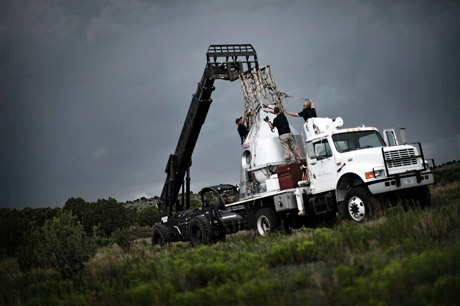
Crew members recover the capsule after the second manned test flight for Red Bull Stratos in Roswell, New Mexico, USA on July 25, 2012. Red Bull Stratos is a mission to the edge of space to an altitude of 37.000 meters to break several records including the sound of speed in freefall. Photo: Jörg Mitter/Red Bull
The capsule suffered damage to its outer shell, framework and other key components upon impact. It was taken to Sage Cheshire Aerospace in Lancaster, CA, where it underwent ten (10) days of intensive testing. Red Bull Stratos Technical Project Director Art Thompson confirmed that the inner pressure sphere – which maintains an artificial atmosphere for the pilot – and key electronic support systems were intact. However certain components of the life support systems are being replaced as a precautionary safety measure. The outer shell will be exchanged, using materials from a reserve capsule.
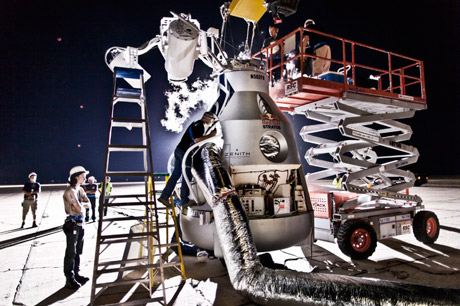
Crew members prepare the capsule for the second manned test flight for Red Bull Stratos in Roswell, New Mexico, USA on July 23, 2012. Photo: balazsgardi.com/Red Bull
The reassembled capsule will undergo a final test in an altitude chamber at Brooks-City Base in San Antonio, TX (Texas), which recreates a stratospheric environment here on Earth. Once this test has been completed successfully on or around 24 September, the craft will be certified safe to fly, with the final mission set for sometime in the first two weeks of October. During this period weather conditions are favorable with calm winds and clear skies essential for the launch of the delicate 55-story high balloon.
Don Day, the mission’s meteorologist, confirmed: “Early fall in New Mexico is one of the best times of year to launch stratospheric balloons.”
Red Bull Stratos
09 Aug 2012
Photos: Joerg Mitter and Balazs Gardi

|


